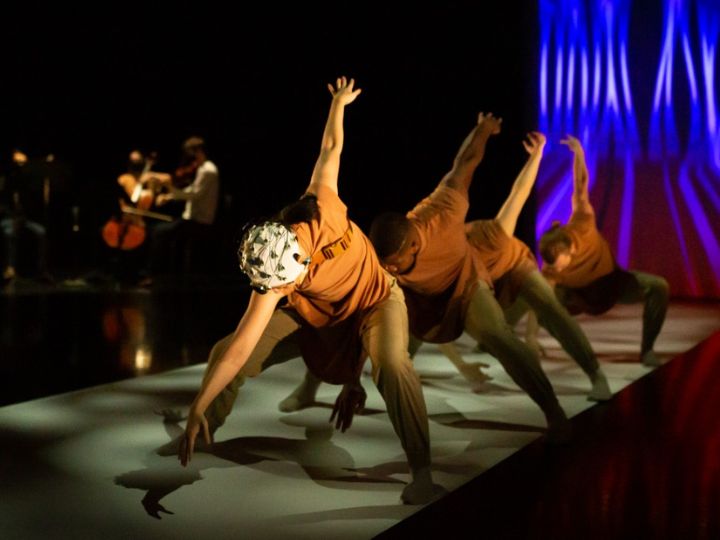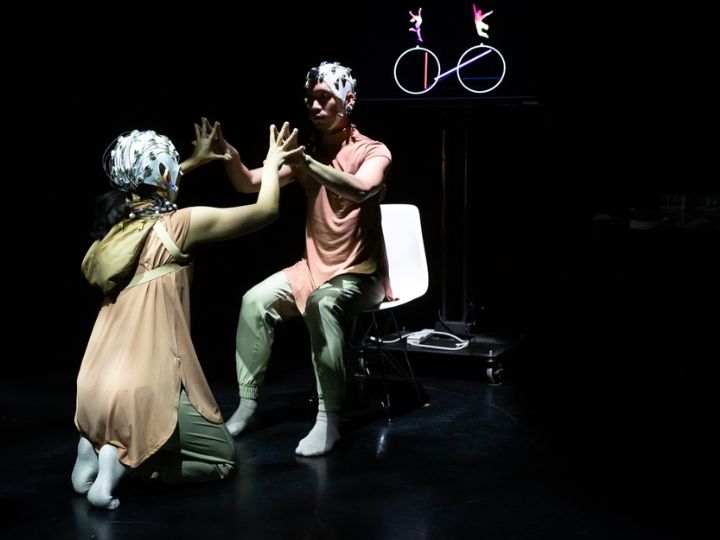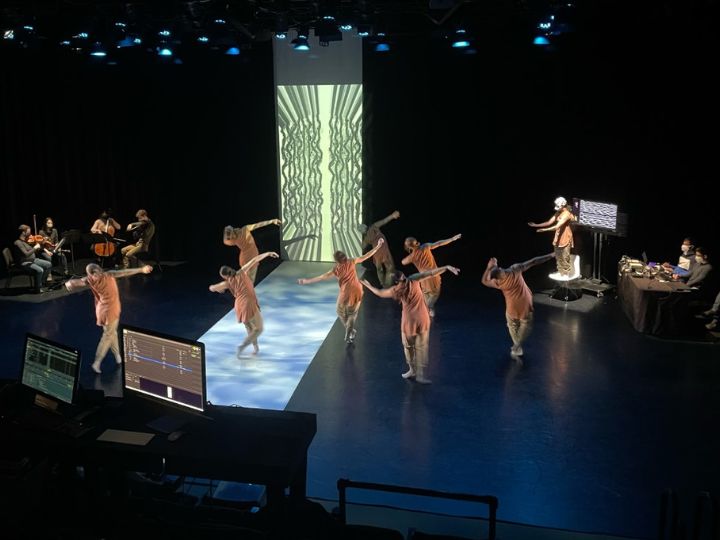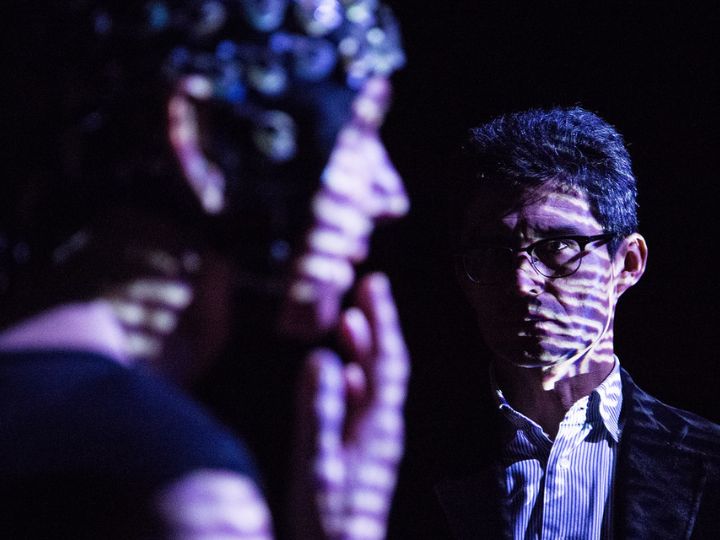



On any given day inside the BRAIN Center at the University of Houston, you might encounter visual artists, dancers and musicians, or even paralyzed individuals – all wearing brain caps to teach researchers about what they are thinking, creating or feeling while they move expressively, or try to regain movement.
Machines and researchers copiously chart the electrical brain signals of the artists moving fluidly through their activities. Those living with paralysis who are re-learning essential movement skills, from young children to older adults, are wearing prosthetics with brain-machine interfaces designed to interpret their thoughts, to help make them move as soon as they think of moving.
Orchestrating all the activity and watching as fellow researchers put his discoveries into practice, is Jose ‘Pepe’ Contreras-Vidal, the neural engineer and “brains” behind the Industry-University Cooperative Research Center (IUCRC) for Building Reliable Advancements and Innovations in Neurotechnology (BRAIN). The partnership between UH and Arizona State University includes industry and world-class academic teams.
“Our team of multi-disciplinary industrial and clinical partners, from the humanities to artificial intelligence, continue developing practical neural prostheses and brain-to-brain interfaces — devices that read brain signals and use them to restore movement or communication in those who have been paralyzed through injury or illness, or to neuromodulate neural signals to restore or extend brain function and/or human performance,” said Contreras-Vidal, who is also the Hugh Roy and Lillie Cranz Cullen Distinguished Professor of electrical and computer engineering at UH and a Fellow of the IEEE and the AIMBE.
A Global Hub Draws a Crowd
A lot has happened within the BRAIN Center since Phase 1 was initially funded by the National Science Foundation in 2017. As the center emerged to become an international hub for emergent neurotechnologies, more members came to join. New international partners – Universidad Miguel Hernandez de Elche (Spain) and Tecnologico de Monterrey (Mexico) – have come aboard. The U.S. Food and Drug Administration (FDA) has joined as an affiliate member along with additional industry members and three new academic sites (Georgia Tech, West Virginia University and University of Maryland Baltimore County), scheduled to join in summer 2023.
And the latest news – the BRAIN Center Phase 2 (2022-2027) has been funded by the NSF with $758,331 going to UH and $240,000 to Arizona, plus another $2 million from industry partners, and the National Institutes of Health (NIH) has bestowed a workforce development grant for $768,135. It will provide specialized training in innovative neurotech, computational tools and neuroengineering techniques to complement and enhance the training and career of therapists, clinical fellows and orthotics and prosthetics professionals.
“The IUCRC program funded by NSF generates breakthrough research by enabling close and sustained engagement between industry innovators, world-class academic teams and government agencies,” said Behrooz Shirazi, program director for the IUCRC program and acting deputy division director of the NSF’s Division of Computer and Network Systems.
Since its inception, the center has attracted 20 industry partners, including companies Medtronic, the CORE Institute, Indus Instruments, Brain Products, as well as medical institutions such as UTHealth Houston and TIRR Memorial Hermann Hospital, ranked No. 2 among the country's top rehabilitation hospitals in the U.S. News & World Report “Best Hospital” rankings for 2020-2021.
“The active collaboration of TIRR Memorial Hermann and UTHealth Houston with the BRAIN Center in identifying, developing and validating innovative neurotech solutions to pressing neurorehabilitation challenges is not only rewarding but critical for improving the quality of life of millions of persons with cognitive and motor disabilities,” said Gerard E. Francisco, M.D., Chief Medical Officer and director of the NeuroRecovery Research Center at TIRR Memorial Hermann and Chair and Professor in the Department of Physical Medicine and Rehabilitation at McGovern Medical School at UTHealth Houston.
The BRAIN Center is also actively engaged in the development of standards for brain-machine interface systems, trustworthy AI applications, use-inspired roadmaps for emergent neurotechnologies, and convergent research at the nexus of the arts, science and medicine. In March, Contreras-Vidal co-chaired the 2022 International Workshop on the Social and Neural Basis of Creative Movement at the Wolf Trap National Center for the Performing Arts sponsored in part by NSF, the National Institutes of Health (NIH), the National Endowment for the Arts (NEA) and BRAIN.
“The BRAIN Center is advancing national health by transferring neurotechnology to end users and promoting access for underrepresented minorities in science, technology, engineering and math,” said Amr Elnaishai, vice president for research and technology transfer at the University of Houston. “They continue to accelerate the progress of science by broadening new participation and retaining current participants.”
If You Think It, It Will Happen
When he’s training patients to walk or move again with the aid of an exoskeleton, Contreras-Vidal encourages them to focus on their end game, or where they want to go. He employs much the same philosophy about the BRAIN Center.
“As we continue to move the needle in brain technology, our center’s mission is being fulfilled, to become a neurotechnology hub by creating a pipeline from discoveries to solutions, while helping students, scientists, engineers and humanists solve one of the greatest unmet medical and health care needs of our time,” said Contreras Vidal, who adds that disability is becoming a leading health care concern because of the increase in survivable trauma and an aging population.
Approximately 5.4 million people in the U.S. are living with paralysis, or one in 50 individuals.
“There is critical need for accessible technologies that can more effectively address the care and rehabilitation needs of these patients,” said Marco Santello, the Arizona State University site director and a co-founder of the BRAIN Center. “Through collaboration and with support from our industry partners, the neurotechnology solutions being developed in the BRAIN Center are making substantial strides to address this need.”